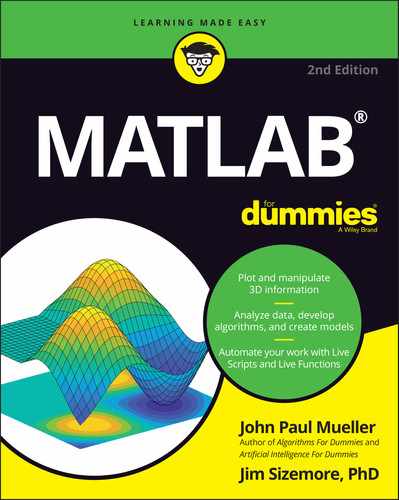Go from total MATLAB newbie to plotting graphs and solving equations in a flash! MATLAB is one of the most powerful and commonly used tools in the STEM field. But did you know it doesn’t take an advanced degree or a ton of computer experience to learn it? MATLAB For Dummies is the roadmap you’ve been looking for to simplify and explain this feature-filled tool. This handy reference walks you through every step of the way as you learn the MATLAB language and environment inside-and-out. Starting with straightforward basics before moving on to more advanced material like Live Functions and Live Scripts, this easy-to-read guide shows you how to make your way around MATLAB with screenshots and newly updated procedures. It includes: Perfect for STEM students and new professionals ready to master one of the most powerful tools in the fields of engineering, mathematics, and computing, MATLAB For Dummies is the simplest way to go from complete newbie to power user faster than you would have thought possible.
Table of Contents
- Cover
- Title Page
- Copyright
- Introduction
- Part 1: Getting Started With MATLAB
- Chapter 1: Introducing MATLAB and Its Many Uses
- Putting MATLAB in Its Place
- Discovering Who Uses MATLAB for Real-World Tasks
- Knowing How to Get the Most from MATLAB
- Getting Over the Learning Curve
- Chapter 2: Starting Your Copy of MATLAB
- Installing MATLAB
- Meeting the MATLAB Interface
- Chapter 3: Interacting with MATLAB
- Using MATLAB as a Calculator
- Understanding the MATLAB Math Syntax
- Organizing Your Storage Locker
- Operating MATLAB as More Than a Calculator
- Recovering from Mistakes
- Chapter 4: Starting, Storing, and Saving MATLAB Files
- Examining MATLAB’s File Structure
- Accessing and Sharing MATLAB Files
- Saving Your Work
- Part 2: Manipulating and Plotting Data in MATLAB
- Chapter 5: Embracing Vectors, Matrices, and Higher Dimensions
- Working with Vectors and Matrices
- Adding and Subtracting
- Understanding the Many Ways to Multiply and Divide
- Working with Higher Dimensions
- Using the Matrix Helps
- Chapter 6: Understanding Plotting Basics
- Considering Plots
- Using the Plot Function
- Modifying Any Plot
- Plotting with 2D Information
- Chapter 7: Using Advanced Plotting Features
- Plotting with 3D Information
- Enhancing Your Plots
- Using the Plot Extras
- Part 3: Streamlining MATLAB
- Chapter 8: Automating Your Work
- Understanding What Scripts Do
- Creating a Script
- Revising Scripts
- Calling Scripts
- Improving Script Performance
- Analyzing Scripts for Errors
- Using the MATLAB Profiler to Improve Performance
- Chapter 9: Expanding MATLAB’s Power with Functions
- Working with Built-in Functions
- Creating a Function
- Using Other Types of Functions
- Chapter 10: Adding Structure to Your Scripts
- Making Decisions
- Creating Recursive Functions
- Performing Tasks Repetitively
- Creating Menus
- Chapter 11: Working with Live Scripts
- Comparing a Live Script to a Regular Script
- Working with the Live Editor
- Running Live Script Sections
- Diagnosing Coding Errors
- Chapter 12: Working with Live Functions
- Comparing a Live Function to a Regular Function
- Understanding Live Function Flexibility Differences
- Converting a Function to a Live Function
- Sharing Live Functions and Live Scripts
- Performing Comparisons and Merges
- Chapter 13: Designing and Using Classes
- A Brief Overview of Object-Oriented Programming (OOP)
- Understanding OOP in MATLAB
- Creating a Basic MATLAB Class
- Chapter 14: Creating MATLAB Apps
- Working with the App Designer
- Defining an Interface
- Making the Interface Functional
- Running the App
- Packaging Your App
- Chapter 15: Building Projects
- Considering the Need for Projects
- Creating a New Project
- Understanding the Project Dependencies
- Running Required Checks
- Part 4: Employing Advanced MATLAB Techniques
- Chapter 16: Importing and Exporting Data
- Importing Data
- Exporting Data
- Working with Images
- Chapter 17: Printing and Publishing Your Work
- Using Commands to Format Text
- Publishing Your MATLAB Data
- Printing Your Work
- Chapter 18: Recovering from Mistakes
- Working with Error Messages
- Understanding Quick Alerts
- Relying on Common Fixes for MATLAB’s Error Messages
- Making Your Own Error Messages
- Using Good Coding Practices
- Part 5: Specific MATLAB Applications
- Part 6: The Part of Tens
- Chapter 21: The Top Ten Uses of MATLAB
- Working with Linear Algebra
- Performing Numerical Analysis
- Designing a Neural Network Simulation
- Getting Involved in Science
- Logging Sensor Data
- Exploring Research
- Creating Light Animations Using Arduino
- Employing Image Processing
- Controlling Industrial Equipment
- Performing Audio Compression Using Wavelets
- Chapter 22: Ten Ways to Make a Living Using MATLAB
- Working with Green Technology
- Creating Speech Recognition Software
- Performing Antenna Analysis and Design
- Getting Disease under Control
- Becoming a Computer Chip Designer
- Working with Robots
- Keeping the Trucks Rolling
- Designing Equipment Used in the Field
- Reducing Risks Using Simulation
- Creating Security Solutions
- Appendix A: MATLAB Functions
- Appendix B: MATLAB’s Plotting Routines
- Index
- About the Authors
- Advertisement Page
- Connect with Dummies
- End User License Agreement
